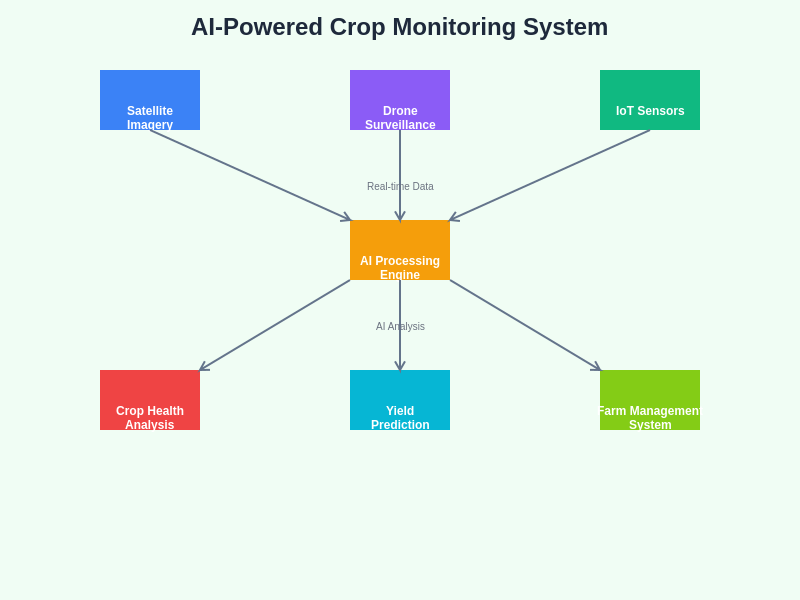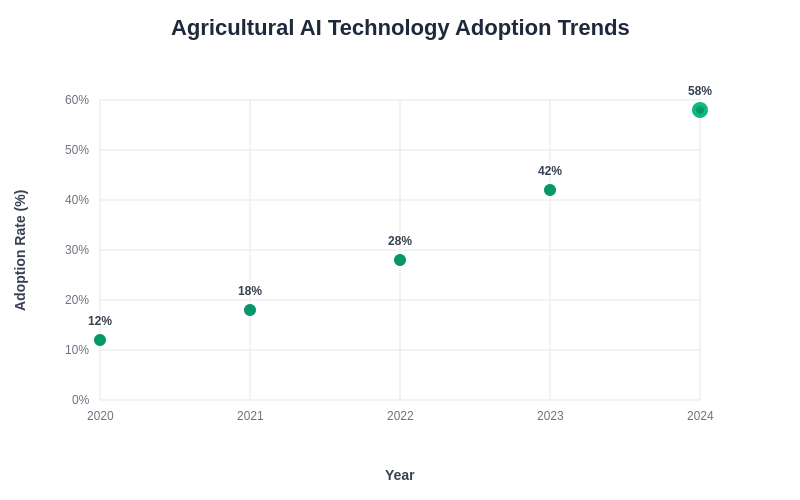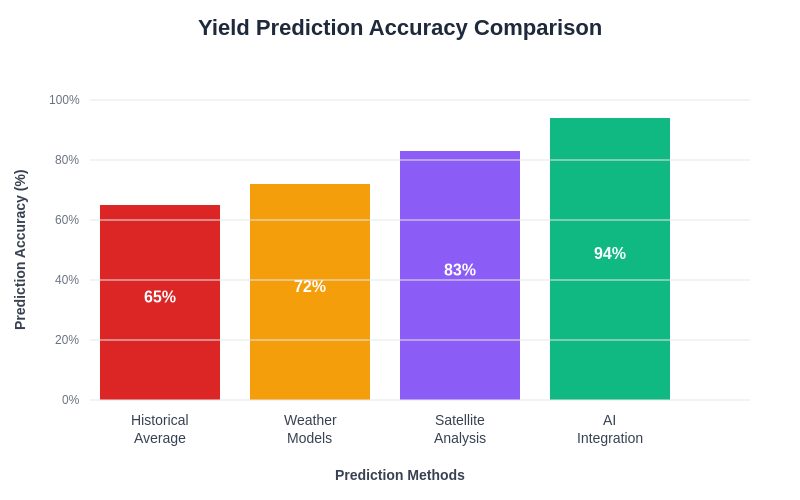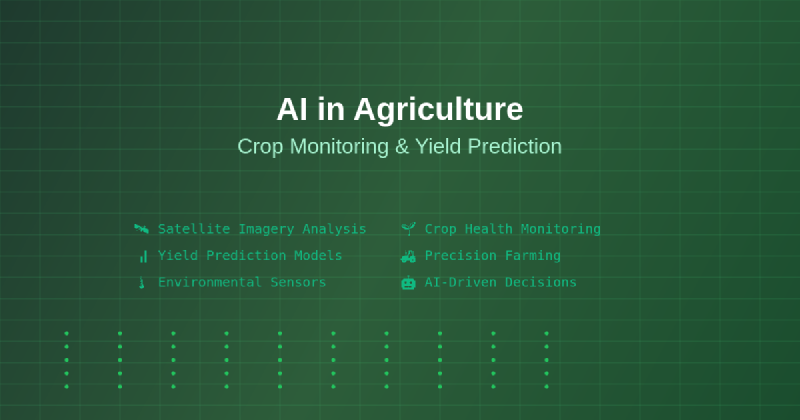The agricultural sector stands at the precipice of a technological revolution that promises to fundamentally transform how we grow, monitor, and harvest crops across the globe. Artificial intelligence has emerged as the cornerstone of this transformation, offering unprecedented capabilities in crop monitoring and yield prediction that are reshaping traditional farming practices. This technological evolution addresses critical challenges facing modern agriculture, including increasing global food demand, climate variability, resource scarcity, and the urgent need for sustainable farming practices that can feed a growing population while preserving our planet’s precious resources.
Explore the latest AI innovations in agriculture to discover cutting-edge technologies that are revolutionizing farming practices worldwide. The integration of artificial intelligence into agricultural systems represents more than mere technological advancement; it embodies a paradigm shift toward data-driven decision-making that optimizes every aspect of crop production while minimizing environmental impact and maximizing economic returns for farmers across diverse geographical and climatic conditions.
The Foundation of AI-Driven Agricultural Intelligence
Modern agricultural AI systems represent the convergence of multiple advanced technologies, including computer vision, machine learning algorithms, satellite imagery analysis, sensor networks, and predictive analytics. These interconnected systems create a comprehensive intelligence framework that continuously monitors crop health, soil conditions, weather patterns, and environmental factors with unprecedented precision and accuracy. The sophistication of these systems enables real-time analysis of vast agricultural datasets, transforming raw information into actionable insights that guide critical farming decisions throughout the growing season.
The foundation of AI-driven agricultural intelligence rests upon the seamless integration of data collection mechanisms that span from ground-level sensors measuring soil moisture and nutrient levels to sophisticated satellite systems that capture multispectral imagery revealing crop health indicators invisible to the human eye. This multi-layered approach to data gathering creates a comprehensive picture of agricultural conditions that enables AI systems to identify patterns, predict trends, and recommend optimizations that significantly enhance crop productivity while reducing resource consumption and environmental impact.
Revolutionary Crop Monitoring Technologies
Traditional crop monitoring methods relied heavily on visual inspections, manual sampling, and historical experience, approaches that were time-consuming, labor-intensive, and often failed to detect problems until significant damage had already occurred. AI-powered crop monitoring systems have fundamentally revolutionized this approach by providing continuous, automated surveillance of crop conditions through sophisticated computer vision algorithms that can identify diseases, pest infestations, nutrient deficiencies, and stress indicators long before they become visible to human observers.
These advanced monitoring systems utilize high-resolution drone imagery, satellite data, and ground-based sensors to create detailed maps of crop health across entire fields, enabling farmers to identify problem areas with pinpoint accuracy and implement targeted interventions that address specific issues without affecting healthy portions of their crops. The precision of these monitoring systems extends beyond simple problem detection to include comprehensive analysis of growth patterns, development stages, and optimal harvesting windows that maximize both yield quantity and quality while minimizing post-harvest losses.
Harness the power of AI with Claude for advanced agricultural analysis and decision-making support that transforms complex agricultural data into clear, actionable insights. The sophisticated analytical capabilities of modern AI systems enable farmers to make informed decisions based on comprehensive data analysis rather than relying solely on traditional intuition and experience, leading to more consistent and profitable agricultural outcomes.
Advanced Yield Prediction Methodologies
Yield prediction has evolved from educated guesswork based on historical averages and seasonal observations to sophisticated AI-driven forecasting systems that analyze hundreds of variables to generate highly accurate predictions of crop yields weeks or even months before harvest. These advanced prediction systems consider weather patterns, soil conditions, crop health indicators, historical performance data, and even global market trends to provide farmers with comprehensive forecasts that enable strategic planning for harvesting, storage, marketing, and resource allocation decisions.
The accuracy of AI-powered yield prediction systems has reached levels that were previously unimaginable, with some systems achieving prediction accuracies exceeding ninety percent for major crops under normal growing conditions. This remarkable precision enables farmers to make informed decisions about crop insurance, forward contracts, equipment scheduling, and labor allocation well in advance of harvest, reducing financial risks and optimizing operational efficiency across all aspects of their farming operations.

The sophisticated architecture of modern AI-powered crop monitoring systems demonstrates the complex integration of multiple data sources and analytical processes that work together to provide comprehensive insights into crop health and performance. This systematic approach ensures that no critical information is overlooked while maintaining the computational efficiency necessary for real-time decision-making support.
Precision Agriculture and Smart Farming Integration
The integration of AI technologies into precision agriculture systems has created smart farming environments where every aspect of crop production is optimized through data-driven decision-making processes. These comprehensive systems monitor and control irrigation schedules, fertilizer applications, pesticide treatments, and cultivation practices with unprecedented precision, ensuring that resources are applied exactly where and when they are needed most effectively. This targeted approach not only maximizes crop yields but also minimizes environmental impact by reducing overuse of water, chemicals, and other agricultural inputs.
Smart farming systems powered by AI continuously adapt to changing conditions throughout the growing season, automatically adjusting management practices based on real-time data analysis and predictive modeling. This dynamic approach to farm management ensures optimal growing conditions are maintained while minimizing waste and reducing the environmental footprint of agricultural operations. The economic benefits of precision agriculture extend beyond simple cost savings to include improved crop quality, enhanced sustainability credentials, and access to premium markets that value environmentally responsible farming practices.
Machine Learning Applications in Crop Disease Detection
The application of machine learning algorithms to crop disease detection represents one of the most impactful implementations of AI in agriculture, providing farmers with early warning systems that can identify disease symptoms before they become visible to human observers. These sophisticated detection systems analyze subtle changes in leaf color, texture, shape, and growth patterns to identify specific diseases, enabling targeted treatment applications that prevent widespread crop damage while minimizing chemical usage and associated environmental impacts.
Advanced machine learning models trained on vast databases of crop images can distinguish between different types of diseases, nutritional deficiencies, and pest damage with remarkable accuracy, providing farmers with specific diagnostic information that guides appropriate treatment decisions. The speed and accuracy of these AI-powered diagnostic systems enable rapid response to emerging threats, often preventing minor issues from developing into major crop losses that could significantly impact farm profitability and food security.
Environmental Monitoring and Climate Adaptation
AI systems in agriculture extend far beyond crop monitoring to include comprehensive environmental analysis that helps farmers adapt to changing climate conditions and optimize their practices for local environmental characteristics. These systems continuously monitor weather patterns, soil conditions, water availability, and environmental stresses to provide farmers with detailed insights into how environmental factors affect crop performance and what adjustments might be necessary to maintain optimal growing conditions.
Climate adaptation strategies powered by AI analysis enable farmers to select appropriate crop varieties, adjust planting schedules, modify irrigation practices, and implement protective measures that help crops thrive despite challenging environmental conditions. This proactive approach to climate management reduces crop losses due to environmental stresses while enabling farmers to take advantage of favorable conditions that might otherwise be overlooked or underutilized.
Discover comprehensive AI research capabilities with Perplexity for in-depth analysis of agricultural trends, climate impacts, and emerging technologies that shape the future of farming. The ability to access and analyze vast amounts of agricultural research and data enables farmers to stay informed about best practices, emerging threats, and innovative solutions that can enhance their operations.
Satellite Imagery and Remote Sensing Technologies
The integration of satellite imagery and remote sensing technologies with AI analysis systems has revolutionized large-scale crop monitoring by providing comprehensive coverage of agricultural areas that would be impossible to monitor through ground-based methods alone. High-resolution satellite images captured across multiple spectral bands reveal detailed information about crop health, growth stages, stress conditions, and yield potential that enables precise management decisions across vast agricultural landscapes.

The accelerating adoption of AI technologies in agriculture demonstrates the growing recognition of artificial intelligence as an essential tool for modern farming operations. This upward trend reflects both technological improvements and increasing farmer awareness of the substantial benefits that AI-powered systems provide for crop monitoring and yield optimization.
AI-powered analysis of satellite imagery can detect subtle changes in crop conditions that indicate emerging problems or opportunities for optimization, enabling farmers to respond quickly to changing conditions across their entire operation. The historical data available through satellite monitoring systems also enables long-term trend analysis that helps farmers understand how their land responds to different management practices and environmental conditions, facilitating continuous improvement in agricultural outcomes.
Sensor Networks and Internet of Things Integration
The deployment of comprehensive sensor networks throughout agricultural operations creates an Internet of Things ecosystem that continuously monitors soil conditions, weather parameters, crop health indicators, and equipment performance. These interconnected systems provide real-time data streams that feed AI analysis engines capable of identifying patterns, predicting problems, and recommending optimizations across all aspects of farm management.
Advanced sensor technologies measure parameters such as soil moisture, nutrient levels, pH, temperature, humidity, light intensity, and atmospheric conditions with high precision and temporal resolution, creating detailed profiles of growing conditions that enable precise management decisions. The integration of this sensor data with AI analysis systems creates automated management capabilities that can adjust irrigation schedules, modify environmental controls, and alert farmers to conditions requiring immediate attention.

The dramatic improvement in yield prediction accuracy achieved through AI-powered systems compared to traditional forecasting methods demonstrates the transformative impact of artificial intelligence on agricultural planning and risk management. These enhanced prediction capabilities enable farmers to make more informed decisions about resource allocation, marketing strategies, and operational planning.
Automated Decision Support Systems
AI-powered decision support systems in agriculture synthesize information from multiple sources to provide farmers with comprehensive recommendations for crop management actions. These sophisticated systems consider current crop conditions, weather forecasts, market prices, resource availability, and operational constraints to generate optimized management plans that maximize profitability while minimizing risks and environmental impacts.
The automation capabilities of modern agricultural AI systems extend beyond simple recommendations to include autonomous implementation of certain management actions, such as irrigation scheduling, climate control adjustments, and equipment operation. This automation reduces labor requirements while ensuring consistent implementation of optimal management practices that might be difficult to maintain through manual operations alone.
Economic Impact and Return on Investment
The economic benefits of implementing AI-powered crop monitoring and yield prediction systems extend far beyond simple cost savings to include significant improvements in crop yields, quality, and consistency that translate into substantial increases in farm profitability. Studies have demonstrated that farms implementing comprehensive AI systems typically experience yield increases of fifteen to thirty percent while reducing input costs by ten to twenty percent through more efficient resource utilization.
The return on investment for agricultural AI systems is typically realized within two to three growing seasons, with continuing benefits that compound over time as systems accumulate more data and refine their predictive capabilities. The economic advantages of AI implementation become even more pronounced during challenging growing conditions when AI-guided management decisions can mean the difference between profitable harvests and significant crop losses.
Sustainability and Environmental Benefits
AI-powered agricultural systems contribute significantly to environmental sustainability by optimizing resource utilization, reducing chemical inputs, and minimizing waste throughout the production cycle. Precision application of water, fertilizers, and pesticides based on AI analysis reduces environmental runoff, soil degradation, and ecosystem disruption while maintaining or improving crop productivity. These environmental benefits align with increasing consumer demand for sustainably produced food and enable farmers to access premium markets that value environmental stewardship.
The carbon footprint reduction achieved through AI-optimized farming practices includes reduced fuel consumption from more efficient equipment operation, decreased chemical production requirements, and improved soil health that enhances carbon sequestration capabilities. These environmental benefits contribute to broader climate change mitigation efforts while providing farmers with additional revenue opportunities through carbon credit programs and sustainability certification schemes.
Global Food Security Implications
The implementation of AI technologies in agriculture has profound implications for global food security by enabling more efficient utilization of existing agricultural land while reducing crop losses due to diseases, pests, and environmental stresses. The ability to predict and prevent crop failures through AI-powered monitoring and prediction systems helps stabilize food supplies and reduces price volatility that can threaten food security in vulnerable populations.
AI-enhanced agricultural productivity is particularly important in regions facing land constraints, water scarcity, or challenging growing conditions where traditional farming methods struggle to maintain adequate food production. The democratization of advanced agricultural technologies through AI systems enables smallholder farmers in developing regions to access sophisticated crop management capabilities that were previously available only to large commercial operations.
Challenges and Implementation Considerations
Despite the tremendous potential of AI in agriculture, successful implementation requires addressing several significant challenges including data quality and availability, technology integration complexity, farmer education and training requirements, and economic barriers that may limit access to advanced systems. The digital divide in rural areas presents additional challenges related to internet connectivity and technological infrastructure necessary to support AI-powered agricultural systems.
The complexity of agricultural AI systems requires ongoing technical support and maintenance that may be challenging to provide in remote agricultural areas. Additionally, the need for customization of AI systems to local crops, growing conditions, and farming practices requires significant expertise and resources that may not be readily available in all agricultural regions.

The accelerating adoption of AI technologies across different agricultural sectors demonstrates the growing recognition of artificial intelligence as an essential tool for modern farming operations. This adoption trend reflects both technological improvements and increasing farmer awareness of the benefits that AI-powered systems can provide for their operations.
Future Developments and Emerging Technologies
The future of AI in agriculture promises even more sophisticated capabilities including advanced robotics integration, enhanced predictive modeling, improved automation systems, and expanded data integration capabilities that will further revolutionize farming practices. Emerging technologies such as quantum computing, advanced sensor technologies, and next-generation satellite systems will enhance the capabilities of agricultural AI systems while reducing costs and improving accessibility.
Research and development efforts continue to focus on developing AI systems that can handle increasingly complex agricultural challenges including climate change adaptation, pest resistance management, and sustainable intensification of crop production. The integration of AI with biotechnology, genomics, and advanced breeding techniques promises to create synergistic effects that will accelerate agricultural innovation and productivity improvements.
Training and Workforce Development
The successful implementation of AI technologies in agriculture requires comprehensive training and workforce development programs that enable farmers, agricultural technicians, and support personnel to effectively utilize these sophisticated systems. Educational initiatives must address both technical aspects of AI system operation and strategic considerations related to interpreting AI-generated insights and integrating them into overall farm management decisions.
The agricultural workforce of the future will require a combination of traditional farming knowledge and technological expertise that enables effective collaboration with AI systems. This evolution in agricultural education and training represents both a challenge and an opportunity for agricultural institutions, extension services, and technology providers to develop innovative educational approaches that prepare farmers for AI-enhanced agriculture.
Policy and Regulatory Considerations
The widespread adoption of AI in agriculture raises important policy and regulatory considerations related to data privacy, technology standards, environmental protection, and fair access to advanced technologies. Governments and regulatory agencies must develop frameworks that encourage innovation while protecting farmers’ interests and ensuring that the benefits of agricultural AI are distributed equitably across different scales and types of farming operations.
International cooperation and standardization efforts will be essential to ensure that AI-powered agricultural systems can operate effectively across national boundaries and contribute to global food security objectives. The development of appropriate regulatory frameworks must balance innovation promotion with risk management to ensure that AI technologies contribute positively to agricultural sustainability and food security goals.
Conclusion: Transforming Agriculture for the Future
The integration of artificial intelligence into crop monitoring and yield prediction represents a fundamental transformation of agricultural practices that promises to address many of the critical challenges facing global food production. The sophisticated capabilities of AI-powered systems enable farmers to optimize their operations with unprecedented precision while reducing environmental impacts and improving economic outcomes. As these technologies continue to evolve and become more accessible, they will play an increasingly important role in ensuring global food security while promoting sustainable agricultural practices that protect our planet’s resources for future generations.
The future of agriculture lies in the intelligent integration of human expertise with AI-powered systems that enhance decision-making capabilities and optimize resource utilization across all aspects of crop production. This collaborative approach between human knowledge and artificial intelligence creates opportunities for innovation and improvement that will benefit farmers, consumers, and the environment while contributing to a more sustainable and secure global food system.
Disclaimer
This article is for informational purposes only and does not constitute professional agricultural or investment advice. The views expressed are based on current understanding of AI technologies and their applications in agriculture. Readers should consult with qualified agricultural professionals and conduct their own research before implementing AI-powered systems in their farming operations. The effectiveness and economic benefits of agricultural AI systems may vary depending on specific crops, growing conditions, farm size, and local market conditions.
